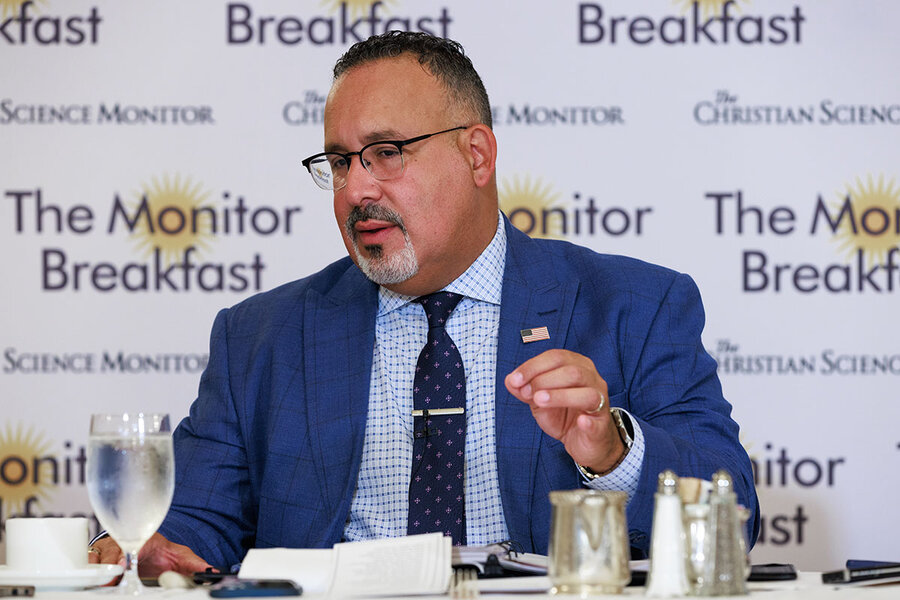Education Secretary Miguel Cardona on debt relief and teacher shortages
Loading...
| Washington
Financing education was a major topic of discussion at today’s Monitor Breakfast conversation between reporters and Education Secretary Miguel Cardona. He made no apologies for the recently announced student debt forgiveness plan, saying, in essence, that what benefits some, benefits all.
“The intent of this debt relief is to make sure borrowers are not worse off after the pandemic than they were before,” Dr. Cardona said. “But to that person that paid off their loan, having their neighbor not go into default helps the local economy.”
Why We Wrote This
From teacher shortages to student debt forgiveness, education in the United States is in the news. At a Monitor Breakfast, Education Secretary Miguel Cardona offered both critiques and solutions.
The secretary has a long and wide-ranging background in education, beginning with teaching fourth grade in Meriden, Connecticut, then serving as principal, assistant superintendent, and finally as the state’s education commissioner, before joining the Biden administration in March 2021.
Asked about his criticism of the college ranking system, Dr. Cardona described a system “that rewards exclusionary practice.”
“There are millions of students out there with tremendous potential – many of whom are the first in their family to go to college – who won’t even be looked at by some of these universities.”
“I’m interested in developing and evolving our system of higher education to promote and reward inclusionary practices,” he added.
Education Secretary Miguel Cardona has a message for Americans who paid off their student loans and aren’t eligible for the federal government’s new debt forgiveness plan.
When asked at a Monitor Breakfast for reporters Wednesday how the plan is fair, he answered, in essence, that what benefits some, benefits all. He compares the program – which is just gearing up and may face legal challenges – to the Paycheck Protection Program, or PPP, the government loans that kept businesses afloat during the height of the pandemic.
“The intent of this debt relief is to make sure borrowers are not worse off after the pandemic than they were before,” Dr. Cardona said. “But to that person that paid off their loan, having their neighbor not go into default helps the local economy.”
Why We Wrote This
From teacher shortages to student debt forgiveness, education in the United States is in the news. At a Monitor Breakfast, Education Secretary Miguel Cardona offered both critiques and solutions.
“We’re not complaining that businesses weren’t forced to shut their doors and we provided support for businesses through PPP,” the education secretary added. “Now we’re investing in Americans to make sure they get back on their feet and move on with their lives.”
Dr. Cardona expressed confidence in the legality of the student debt forgiveness program. Last year, both President Joe Biden and House Speaker Nancy Pelosi had asserted that congressional approval would be required to fund student debt relief – with cost estimates to the federal government of between $300 billion and $500 billion. (Individuals making under $125,000 – and married couples earning under $250,000 – a year are eligible for $10,000 in debt forgiveness, or $20,000 in relief from Pell Grants.)
Now, the Biden administration is basing its ability to bypass Congress on a law passed in 2001 aimed at responding to war or another national emergency.
“Under the HEROES Act, I do have the ability to waive certain provisions to ensure that students are not worse off after the pandemic than they were before,” Dr. Cardona says, referring to the Higher Education Relief Opportunities for Students Act.
The education secretary says he “would welcome Congress’ action on this, because it is an issue that affects all Americans.”
And what about the underlying structural issues of how higher education is funded in this country, a system that has become increasingly unaffordable to people of modest means?
Dr. Cardona points to other efforts to make postsecondary education more affordable. One initiative involves income-driven repayment, which would cut student loan payments from 10% of a person’s income to 5%.
The education secretary brought to the table his background as an educator in Meriden, Connecticut – first as a fourth grade teacher, then as a principal and assistant superintendent, and finally as the state’s education commissioner, before joining the Biden administration in March 2021.
From his days as a principal, Dr. Cardona recalls a “really bright” boy in the sixth grade whose father declared that his son would not be going to college. “I just can’t afford it,” the man told him.
“The parent made a decision based on the fact that he knew he couldn’t afford college, you know – six years later that his son wasn’t going to college,” Dr. Cardona says. “That happens too often across our country. So we’re proud of the debt relief.”
The C-SPAN video of our breakfast with the education secretary can be viewed here.
Following are more excerpts from the breakfast, lightly edited for clarity:
What are other ways to fix the “broken system” of higher education financing?
Public service loan forgiveness. If you choose a profession where you’re serving the public, in many cases, you don’t do that because it pays like the private sector. You’re doing it to make the community better. So we’re making sure that the public service loan forgiveness law is implemented correctly.
When I became secretary of education, there was a 98% denial rate for public servants who paid their loans for 10 years, who served the public for 10 years and applied for this. Within a year of our fixing the broken system, we provided over $10 billion in loan forgiveness. Over 175,000 people have benefited from it.
We’re fighting to double Pell Grants so that more students who have maybe less resources growing up still have college accessible to them.
We’re going to be working very closely with our higher education institutions to ensure that we’re lifting up those universities that provide a good return on investment for students. You know, the days of going to college and leaving with $150,000 in debt and then getting a job paying $35,000 a year doesn’t cut it.
You recently referred to college ranking systems as a “joke,” taking particular aim at the most selective colleges’ obsession with rankings. What is it that gets under your skin?
There are millions of students out there with tremendous potential – many of whom are the first in their family to go to college – who won’t even be looked at by some of these universities.
I believe we have a system that rewards exclusionary practice. I’m interested in developing and evolving our system of higher education to promote and reward inclusionary practices. I don’t have to tell you that when students graduate, we still have disparities in achievement. The NAEP [National Assessment of Educational Progress] – the nation’s report card – is a symptom of the fact that in our K-12 systems, race in places still serves as a determinant of success, sadly, almost as a predictor.
Right now, an infusion of federal cash is helping K-12 schools. But what happens when that funding ends?
Federal spending on education makes up about 10% of education funding total. My challenge is to the other 90%: Match the president’s urgency. If we go back to the funding that was there in March 2020, we should not expect different results.
And how will a potential funding shortfall affect teacher “pipeline” programs, meant to address a shortage of K-12 teachers?
I’m visiting Tennessee next week as part of the back-to-school tour. I’m excited about that. Tennessee has a tremendous apprenticeship program, a Grow Your Own program that’s embedded throughout the state where it’s much like an apprenticeship for a trade.
They’re looking at solutions, viable solutions that are long term. There has to be an investment in those programs by states.
My push is not only to make sure we’re using the federal funds to create programs, but also to elevate the urgency in state and local governments on ongoing funding on those issues that are so important.








